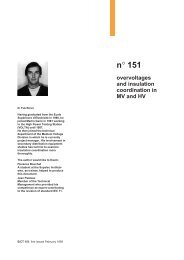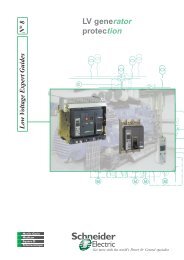sepam 20 user manual - Schneider Electric
sepam 20 user manual - Schneider Electric
sepam 20 user manual - Schneider Electric
You also want an ePaper? Increase the reach of your titles
YUMPU automatically turns print PDFs into web optimized ePapers that Google loves.
Commissioning Commissioning: principles and<br />
method<br />
PCRED301005EN - 06/<strong>20</strong>08<br />
DANGER<br />
HAZARD OF ELECTRIC SHOCK, ELECTRIC<br />
ARC OR BURNS<br />
b Only qualified personnel should commission<br />
this equipment. Such work should be performed<br />
only after reading this entire set of instructions.<br />
b NEVER work alone.<br />
b Obey all existing safety instructions when<br />
commissioning and maintaining high-voltage<br />
equipment.<br />
b Beware of potential hazards and wear<br />
personal protective equipment.<br />
Failure to follow these instructions will result<br />
in death or serious injury.<br />
Protection relay testing<br />
Protection relays are tested prior to commissioning, with the dual aim of maximizing<br />
availability and minimizing the risk of malfunction of the assembly being<br />
commissioned. The problem consists of defining the consistency of the appropriate<br />
tests, keeping in mind that the relay is always involved as the main link in the<br />
protection chain.<br />
Therefore, protection relays based on electromechanical and solid state<br />
technologies must be systematically submitted to detailed testing, not only to qualify<br />
relay commissioning, but also to check that they actually are in good operating order<br />
and have the required level of performance.<br />
The Sepam concept makes it possible to do away with such testing.<br />
In effect:<br />
b The use of digital technology ensures the reproducibility of the stated<br />
performances<br />
b Each of the Sepam functions has undergone full factory qualification<br />
b An internal self-testing system provides continuous information on the state of the<br />
electronic components and the integrity of the functions (e.g. automatic tests<br />
diagnose the level of component polarization voltages, the continuity of the analog<br />
value acquisition chain, non-alteration of RAM memory, absence of settings outside<br />
the tolerance range) and thereby ensures a high level of availability.<br />
Sepam is therefore ready to operate without requiring any additional<br />
qualification testing that concerns it directly.<br />
Sepam commissioning tests<br />
The preliminary Sepam commissioning tests can be limited to a commissioning<br />
check, i.e.:<br />
b Checking compliance with BOMs and hardware installation diagrams and rules<br />
during a preliminary general check<br />
b Checking compliance of the general settings and protection settings entered with<br />
the setting sheets<br />
b Checking current or voltage input connections by secondary injection tests<br />
b Checking logic input and output connections by simulation of input data and<br />
forcing of output status<br />
b Validating the complete protection chain<br />
b Checking the connection of the optional MET148-2 and MSA141 modules.<br />
The various checks are described further on.<br />
General principles<br />
b All the tests should be carried out with the MV cubicle completely isolated<br />
and the MV circuit breaker racked out (disconnected and open)<br />
b All the tests are to be performed under operating conditions: no wiring or<br />
setting changes, even temporary changes to facilitate testing, are allowed.<br />
b The SFT2841 parameter setting and operating software is the basic tool for all<br />
Sepam <strong>user</strong>s. It is especially useful during Sepam commissioning tests. The tests<br />
described in this document are systematically based on the use of that tool.<br />
Method<br />
For each Sepam:<br />
b Only carry out the checks suited to the hardware configuration and the functions<br />
activated<br />
b Use the test sheet provided to record the results of the commissioning tests.<br />
A comprehensive description of all the tests is given further on:<br />
b Checking phase current input connections<br />
v with 1 A/5 A transformer, see page 7/25<br />
v with LPCT type current sensor, see page 7/26<br />
b Checking the residual current input connection, see page 7/27<br />
b Checking phase voltage input connections, see page 7/28<br />
b Checking the residual voltage input connection, see page 7/29.<br />
7/21<br />
7

















